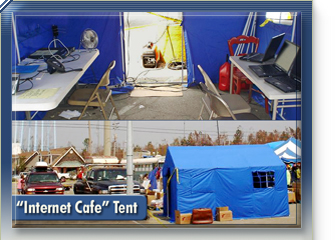Toolkits & Best Practices
The attempt to assemble "best practices" is an effort to distill
clear guidelines from the real-world experiences of professionals who have
already faced the inevitable challenges—and overcome them. Best practice
statements are the record of how those challenges were minimized and resolved.
An important document on the topic of Toolkits and Best Practices from
DoD’s
perspective is linked on this page. The document is entitled "An ICT Primer:
Information and Communications Technologies for Civilian-Military Coordination
in Disaster Relief and Stabilization and Reconstruction" by Larry Wentz (National
Defense University’s Center for Technology and National Security Policy).
Part Two of that document, entitled TOOLKITS AND BEST PRACTICES, focuses
on the basics of telecommunications networks, telecommunications needs
in Stabilization and Reconstruction and Humanitarian Assistance/Disaster
Relief operations. This section of the ICT Primer also outlines a commonly
deployed ICT architecture we will likely face (and more importantly need to
interoperate with) in natural or manmade disasters. This section of the ICT
Primer also addresses one of the most critical elements of a successful multi-national,
multi-organizational response -- that of collaborating at the civilian-military
boundary. Countless previous disasters of all kinds reminds us of how hard
it is for governments to work with military organizations, International
Organizations (IOs), and Non-Government Organizations (NGOs). The mechanisms
suggested in the ICT Primer describe many of these organizations and how
they can/should work together for common goals in disaster response.
Read full document here: ICT Primer (PDF, 1MB).
One more critically important document for everyone in DoD to be aware of, to understand, and to comply with at the civilian-military boundary is DoD Directive 3000.05 (linked on this page). This DoD Directive sets policy - from the Pentagon - for how DoD must work better at the civilian-military boundary. DoD should (and does) conduct regular training and exercises with such other civilian organizations (IOs and NGOs) as well as with other elements of the U.S. government and the governments of the entire international community. We also by necessity and convenience inter-depend on each other - and this DoD Directive delves into detail on how to do all of this better.
Read full document here: DoD Directive 3000.05 (PDF, 108KB).
